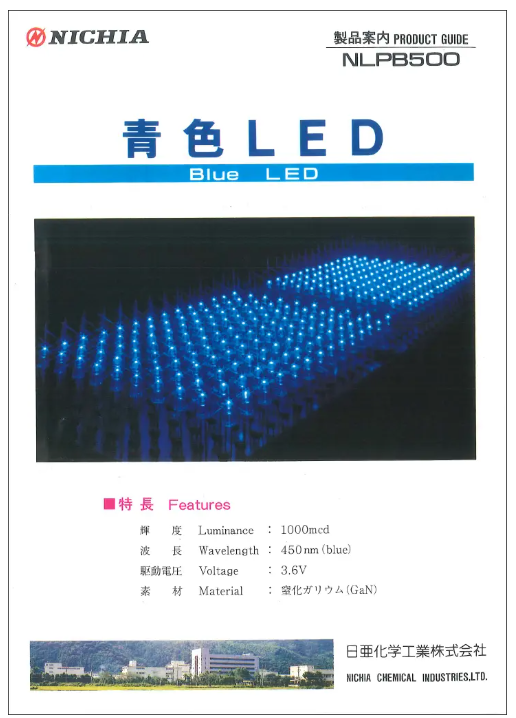Blue LEDs were ready for mass production, and in November 1993, the day of the launch announcement for the blue LED finally arrived. The announcement was not some gorgeous event like renting out a conference room at a hotel to give a presentation to a large number of media outlets; instead, Nichia just asked the Tokushima branch of the Nihon Keizai Shimbun (Japanese Newspaper company) for an interview. At that time, Nichia Corporation was a completely unknown company to the public. The company was introduced in newspapers, weekly magazines, television, and other media as "the company with the longest summer vacation in Japan1" once a year. This was how Nichia was known to the public. Also, Nichia was concerned that people would not believe it if Nichia simply announced that Nichia had developed an innovative LED because Nichia was a chemical company with only a few hundred employees in Tokushima which was a rural area at that time.
Therefore, Nichia needed to show that its innovative announcement of "launching a blue LED that is 100 times brighter than conventional LEDs" was not an exaggeration and prepared with the following points in mind:
-
On the day of the announcement, instead of just showing documents and photos, the team must prepare many samples that could be lit up for the event.
-
The product catalog must show photos of many lit blue LEDs, not just one.
Compared to logic semiconductors, LEDs, which are opto-semiconductors, are simple to explain, and their value can be easily understood if people see them glowing brightly, so preparing "glowing" products was a top priority.
In the LED industry at that time in 1993, many companies developed and received orders for customized products whose specifications were determined in response to detailed customer requests. As for selling the blue LEDs, Nichia focused on the marketing perspective and internally reviewed the specification needed to support a wide range of applications. Then, Nichia decided to sell the blue LED as a standard product.
Thus, Nichia's first mass-produced blue LED "NLPB500" with a brightness of 1000mcd was announced and an interview was held at one of Nichia's meeting rooms. This led to the "Blue LED, 100 times brighter" mentioned at the beginning of the first article in this blog series. (At that time, the brightest blue LED from another company was 10mcd.)
The firing furnace used for manufacturing phosphors, Nichia's major product at that time, reached high temperatures, and therefore it was not suitable to operate it during the summer. Additionally, it was necessary to turn off to do maintenance once a year. Many of the employees also worked as rice farmers, and the rice harvest coincided with the summer vacation period in the middle of August. Therefore, the summer vacation was about three weeks. It is also said that since one of the local summer festivals and the “Awa Odori”, which is as famous as the Rio Carnival, are held in the middle of August, employees were too excited and could not sit still. Additionally, the founder was a mountaineering enthusiast who climbed Mt. Kilimanjaro in Africa after he turned 70 and wanted to take a long vacation himself. The actual truth is not known. Today, while the number of annual vacations has increased since those days, the number of employees has also increased, resulting in a summer vacation of approximately one week to ten days.

Figure 1. The product catalog of Nichia's first mass-produced blue LED "NLPB500"
Note:
NLPB500 is Nichia's part number.












